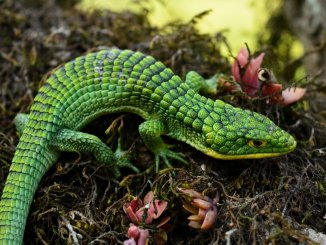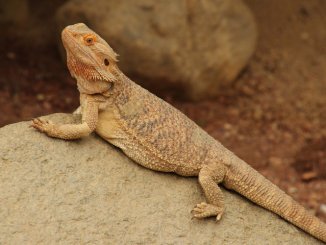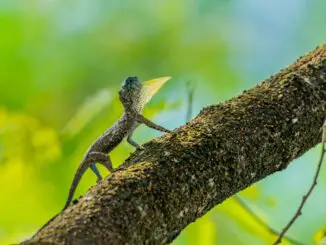The roughneck monitor is a medium-to-large-sized monitor lizard with a long body, pointed snout, and large pointed scales on its neck.
Roughneck monitors are found in the South-East Asian countries of Malaysia, Burma, Thailand, and surrounding territories.
Its preferred habitat is the mangrove swamp and rainforest areas of these countries.
This monitor lizard species has a calm disposition and enjoys a life expectancy of between 10 and 20 years.
While not particularly difficult to care for, you do need to pay strict attention to its temperature and humidity requirements, making it a more suitable pet for reptile owners with some experience.
Roughneck Monitor Overview
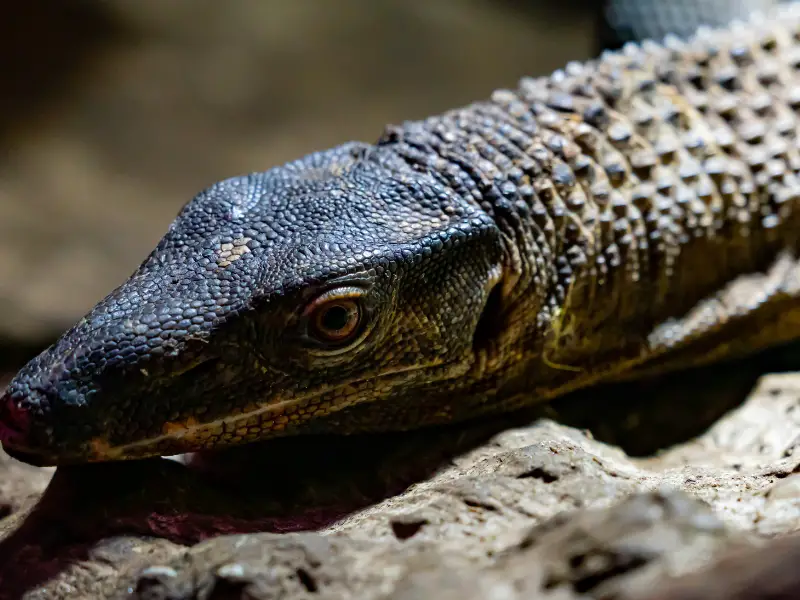
| Common name | Roughneck monitor, Dumeril’s monitor |
| Scientific name | Varanus rudicollis, Varanus dumerilii |
| Natural habitat | Southeast Asian mangrove swamps, and rainforests. |
| Adult size | 36 - 48 inches, although they can grow up to 60 inches. |
| Average lifespan | 10 - 20 years |
| Diet | Carnivores |
| Housing | Large cage or enclosure (72” x 72” x 24”) |
| Experience | Intermediate |
Origin
Roughneck monitors can be black (Varanus rudicollis) or brown (Varanus dumerilii) in color and can be found throughout South East Asia, where they reside in rainforests and mangrove swamps.
They are usually spotted on the forest floor, near fallen logs, on tree stumps, or near streams.
In the wild, these monitors reside in southern Myanmar, southern Thailand, Sumatra, Borneo, and Peninsular Malaysia.
They can be found in the national parks of these countries, however, you rarely spot them in the wild.
This is especially true of the black variety.
Appearance And Behavior
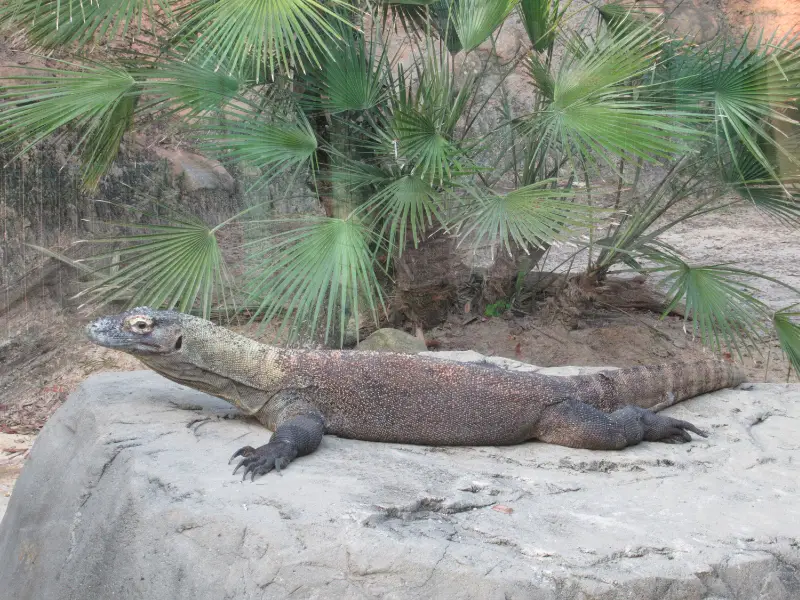
As previously mentioned, these monitors can be black or brown.
The two species are often confused with each other and have similar care requirements. However, there are slight differences in their appearance.
The black monitors are easily identifiable due to the rough, pyramid-like scales on the back of their necks and their bird-like heads.
In infancy, these monitors are primarily black with yellow or blue spots or bands.
By the time they reach adulthood, these markings disappear and the skin becomes entirely black or gray.
Brown roughneck monitors, on the other hand, have brown skin, spinier scales, and narrower snouts.
They hatch with brilliant orange heads and black bodies.
This bright coloration fades within a few weeks. The brown monitors are also known as Dumeril’s monitors.
Roughneck monitors are arboreal, which means they live in trees. They are also diurnal, which means they’re active in the daytime.
They love climbing and spending time in the water. Because they like to be in the water, their nostrils have an adapted scale that seals them shut underwater.
Size And Lifespan
Although larger species of black roughneck monitors (up to 60 inches in length) have been reported, the usual adult size is 36 inches to 48 inches.
The brown roughneck monitor is a similar size but has not been reported to exceed 48 inches.
Compared to some other monitor species, roughnecks have fairly slender bodies with long necks. Their tails may grow up to 1.6 times the length of the snout-vent.
The lifespan of roughnecks, even in captivity, will vary between 10 to 20 years. This makes them ideal as pets, and worth the time and effort put into raising them.
Temperament
The temperament of roughneck monitors is what makes them a great choice for intermediate and experienced reptile keepers.
These creatures are not aggressive and prefer to run away, puff up, or play dead rather than fight. Once tamed, they can be handled successfully and are unlikely to bite.
You can keep this monitor in an enclosure like a cage, but remember it is an arboreal reptile. This means that there should be climbing structures in the enclosure.
Although they’re not aggressive, it is best to house these lizards individually.
If you choose to house two together, they should both be females, and the enclosure size recommended below will have to be doubled.
Two males housed together will fight, especially if a female is present. This can lead to your monitors being hurt, which is best to avoid!
Housing Roughneck Monitors
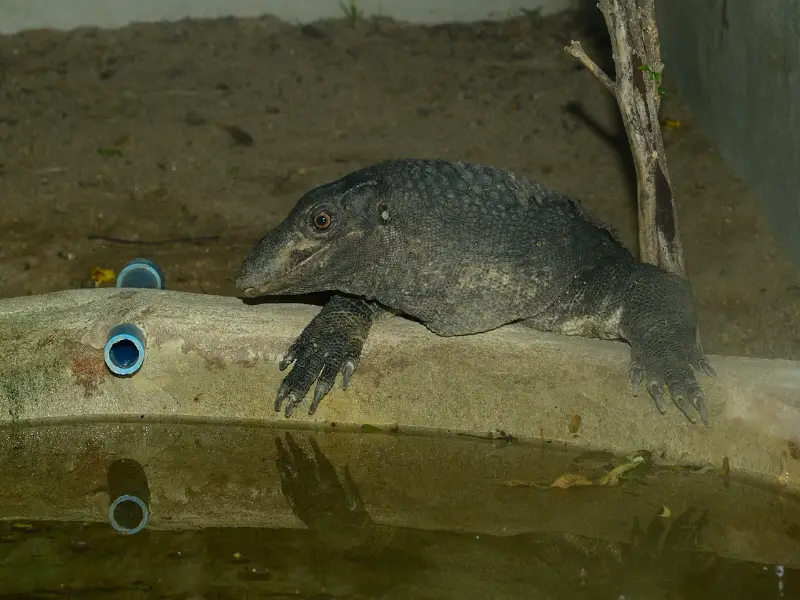
When keeping an arboreal monitor, keep the following points in mind.
Firstly, install or build an enclosure with enough room for your monitor to walk around. You may use a glass terrarium if it is large enough.
Ensure there is plenty of opportunity for your monitor to climb. Mimic their natural habitat as closely as possible, with branches, bark, cork, and/or moss.
They love to hide in boxes, as many other reptiles do. Create one for your monitor with an old birdhouse or a similar container.
You could also make one yourself, out of cork tubes or similar materials.
Coconut husks and live plants will add variety and maintain humidity in the enclosure.
Be warned though, that this curious creature will more than likely dig up the plants. They are quite inquisitive about their surroundings.
Enclosure Size
Terrariums for housing monitor lizards can be bought from reptile handlers. Note that ordinary terrariums online are often not big enough, so ensure that you know the size before you buy.
Screen enclosures are not recommended, as it is difficult to maintain the correct humidity.
The minimum recommended size for your monitor’s enclosure is 72 inches wide and high, and 24 inches deep. If you can go bigger, then do so.
The bigger the better for these monitors! Include plenty of structures to climb on, such as branches, twigs, and log stumps.
You may find it easier to custom-build an enclosure if you have the space. Beware of some types of plywood, though, as they can be toxic to reptiles.
Birch, maple, or oak woods are safe to use, in combination with glass or plexiglass doors.
Lighting
Lizards, and other cold-blooded reptiles, need to bask in the sun daily to keep warm. This is called thermoregulation. However, it’s not the only reason they bask!
Basking allows reptiles to get their necessary dose of vitamin D. To keep your monitors healthy, you need to recreate their basking environment.
UV lighting can be used to meet the light and heat requirements for your monitor’s enclosure, for mimicking daytime conditions.
For the basking area, use a 45W halogen lamp, located above and to one side of the enclosure.
Your roughneck monitor will choose to bask under the lamp’s heat and light or seek shelter in cooler places throughout the day.
Provide a basking area by keeping the lamp going for about 10 hours a day.
Temperature And Humidity
The enclosure should ideally have a range of temperatures. Under the basking lamp, temperatures should reach between 130°F to 150°F.
Elsewhere in the enclosure, the temperature should be around 86°F, especially at night.
Your monitor should be able to move freely between the heat of the lamp and cooler areas.
In Southeast Asian countries, and Indonesia where this reptile is also found, humidity varies between 72% and 86% so try to mimic this in your enclosure.
Keep a spray bottle handy to mist the enclosure regularly. Place a water bowl inside as well. This will keep the humidity levels high enough.
Alternatively, invest in an automatic mister to help keep humidity levels constant and accurate.
Roughneck monitors need these conditions to survive and thrive, so check the temperatures and humidity levels regularly.
A thermometer to check the temperature, and a hygrometer to check humidity, are essential tools.
Substrate And Decoration
To maintain an enclosure that is similar to the natural environment, you’ll need to provide climbing opportunities for your monitor.
Include small branches of driftwood, maple, or oak. Sanitize any branches that you collect yourself.
Use layers of soil, coir, and sand for an optimal substrate. This needs enough depth, preferably with leaf litter strewn on the surface.
The correct substrate will help to maintain the humidity in the enclosure, especially if you use coconut coir, which is known to hold moisture well.
Provide enough stimulation in the enclosure for your monitors, as they are inquisitive! Roughneck monitors are terrestrial, aquatic, and arboreal.
To provide enough stimulation, your enclosure needs to be varied. This is why you may need to custom-build an enclosure to accommodate your monitor appropriately.
Give them enough space to climb, scratch around, and explore.
Include a water bowl for drinking, and perhaps a secondary one to bathe in. Otherwise, it may use its drinking water as a bathroom and pool.
Cleaning
Keep the enclosure clean with regular spot cleaning.
Scrub the water bowl at least once a week, but, more often if you notice slime building up. Your reptile may use it as a bathroom spot, so you’ll probably need to refresh the water regularly.
A good rule of thumb is to change the water bowl each day.
Black roughneck monitors will venture into the water bowl for the occasional quick dip, but the brown species can spend hours in the water.
Keeping the water bowl clean will prevent infections and skin diseases.
One of the most common mistakes beginners make with pet lizards is getting the enclosure humidity wrong. This is essential, as the correct humidity should keep shedding under control. These reptiles shed in pieces.
Remove any old food, excrement, or debris lying on the surface of the enclosure. Or use a bioactive substrate to ensure that anything you miss is biodegradable.
A bioactive substrate is available from reptile suppliers to keep the biome free from bacterial imbalance and makes cleaning easier.
Breaking down organic waste prevents illness-causing bacteria from decaying food or waste you miss when cleaning the enclosure.
If you have not used it you’ll have to churn the substrate a couple of times a month and filter out any decaying debris.
Roughneck Monitor Care
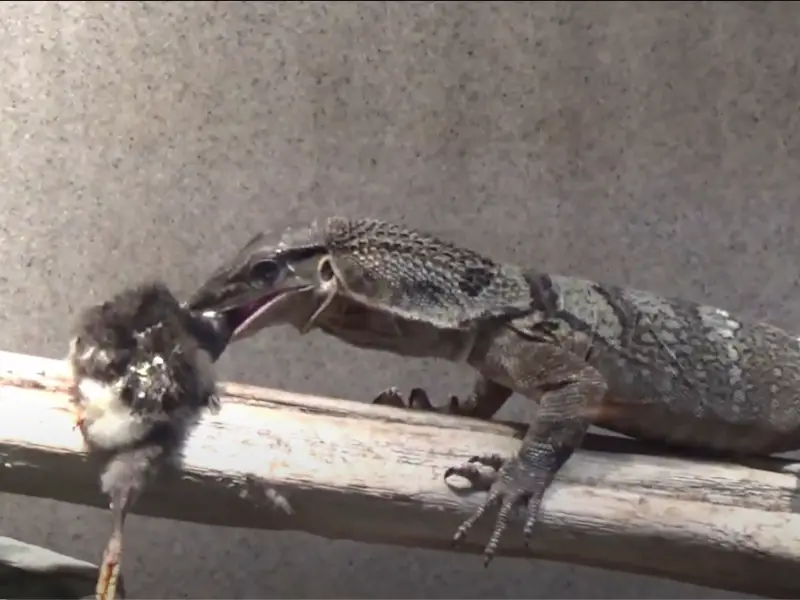
If you keep a careful eye on the heat and humidity in your enclosure, your roughneck monitor should do very well.
Bear in mind that these monitors need a varied enclosure habitat and require an intermediate level of care. Some experience with monitor reptiles would be advantageous.
Food And Water
Infant roughneck monitors consume small cockroaches and crickets.
Avoid feeding them furry mice and rats, as they can’t digest the hair. By adulthood, they can eat mice, but these should be fed sparingly.
Try to align their diet with what they eat in the wild: Dubia roaches, grasshoppers, small mammals, and fish. Grown monitors also love to feast on large roaches and even crayfish.
These monitors have healthy appetites, and you should feed them until they are full.
Dust the feeder insects with good calcium/vitamin powders designed for reptile care. You can give them turkey, chicken, and egg occasionally too.
Brown roughneck monitors like crab meat as well as other shellfish.
Monitors need an ample supply of fresh water. Change the water every day, to keep a clean supply going. If your monitor is soaking for too long, this could point to a humidity problem.
Handling
These monitors are docile reptiles. They don’t mind being handled and will hiss rather than bite. That said, handling them can be a challenge due to their sharp claws.
You may need a towel to pick them up to avoid injury. They’re easily trained and can become tame, but this requires some patience in the beginning.
Naturally curious, your monitor will soon become accustomed to your movements and the sound of your voice.
If you have an enclosure where your pet can see you moving around, it will get used to you more quickly.
Once monitors make the connection between you and food, your bond will strengthen. This can take weeks or even months. But, when they are accustomed to you, they will come to you when you are near the enclosure.
Common Health Issues
These monitors are robust reptiles and suffer few health problems, but the infants may be more delicate. The main task is to keep the temperature and humidity at the right levels.
Something to watch for is feeding boredom, as monitors can be picky eaters when they lack variety. Try not to feed your monitor the same food at every meal.
This will ensure that they continue to eat enough.
Black roughneck monitors are mostly insectivores. Try to include variety in the insects, and always dust them with reptile calcium powder.
Taming Your Roughneck Monitor
Taming your monitor might take a bit of time and patience. Look at their behavior after your initial attempts at handling cues to their comfort zone.
Your monitor needs to acclimatize to its new environment before any handling takes place.
Start with a few minutes at a time, and watch how they react. Increase time out of the enclosure, being handled, slowly.
If your monitor reacts by hiding for days afterward, reduce the frequency and duration of handling.
This reptile does eventually enjoy being handled if you respect the initial trust-building period.
Breeding
Captive-bred specimens are rare. And there aren’t many resources to follow if you’re interested in breeding these monitors. However, there is evidence that they breed in captivity.
Communal housing and breeding are best left to experienced monitor reptile keepers.
Choosing And Buying A Roughneck Monitor
Due to the rarity of captive-bred specimens, most monitors for sale have been wild-caught and imported. However, it is illegal to trade any wild-caught native monitor lizards from the Philippines.
Make sure that you only buy from a reputable source, with the necessary documentation. They can cost anywhere from $100 to $350.
While roughneck monitors can make great pets, they are more suited to more experienced reptile owners.
Only buy this reptile if you have enough space to adequately house it, and you’re prepared for all the care and maintenance required.

